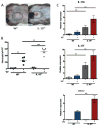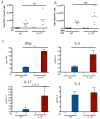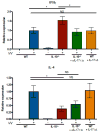IL-10 suppresses IL-17-mediated dermal inflammation and reduces the systemic burden of Vaccinia virus in a mouse model of eczema vaccinatum
- PMID: 24412909
- PMCID: PMC3946343
- DOI: 10.1016/j.clim.2013.11.010
IL-10 suppresses IL-17-mediated dermal inflammation and reduces the systemic burden of Vaccinia virus in a mouse model of eczema vaccinatum
Abstract
Individuals with atopic dermatitis (AD) are susceptible to a severe, potentially fatal, systemic infection and inflammatory response following exposure to Vaccinia virus (VV). IL-10 acts both as an inducer of Th2 responses and as a regulator of T cell activation. It has been shown to limit skin inflammation elicited by contact sensitizers. AD exacerbations have been associated with decreased IL-10 function. We used IL-10(-/-) mice to test the role of the cytokine in VV immunity. They exhibited larger primary lesions and increased cutaneous neutrophil infiltration compared to wild-type (WT) counterparts. This was associated with enhanced production of IL-17A, IL-17F and CXCL2. Paradoxically, despite intact adaptive immune responses, tissue viral burdens were increased in IL-10(-/-) mice. These findings suggest that IL-10 is important in limiting skin inflammation induced by VV and that abnormal IL-17-driven neutrophil recruitment at the primary infection site in the skin results in increased systemic viral dissemination.
Keywords: Atopic dermatitis; Eczema vaccinatum; Vaccine.
Copyright © 2013 Elsevier Inc. All rights reserved.
Figures





Similar articles
-
Filaggrin deficiency promotes the dissemination of cutaneously inoculated vaccinia virus.J Allergy Clin Immunol. 2015 Jun;135(6):1511-8.e6. doi: 10.1016/j.jaci.2014.12.1923. Epub 2015 Jan 30. J Allergy Clin Immunol. 2015. PMID: 25649082 Free PMC article.
-
Vaccinia virus inoculation in sites of allergic skin inflammation elicits a vigorous cutaneous IL-17 response.Proc Natl Acad Sci U S A. 2009 Sep 1;106(35):14954-9. doi: 10.1073/pnas.0904021106. Epub 2009 Aug 17. Proc Natl Acad Sci U S A. 2009. PMID: 19706451 Free PMC article.
-
Inhibition of NK cell activity by IL-17 allows vaccinia virus to induce severe skin lesions in a mouse model of eczema vaccinatum.J Exp Med. 2009 Jun 8;206(6):1219-25. doi: 10.1084/jem.20082835. Epub 2009 May 25. J Exp Med. 2009. PMID: 19468065 Free PMC article.
-
Vaccinia virus pathogenicity in atopic dermatitis is caused by allergen-induced immune response that prevents the antiviral cellular and humoral immunity.Virus Genes. 2003 Dec;27(3):269-82. doi: 10.1023/a:1026399916888. Virus Genes. 2003. PMID: 14618088 Review.
-
Eczema vaccinatum.Clin Infect Dis. 2012 Mar;54(6):832-40. doi: 10.1093/cid/cir952. Epub 2012 Jan 30. Clin Infect Dis. 2012. PMID: 22291103 Review.
Cited by
-
Vaccinia Virus Expressing Interferon Regulatory Factor 3 Induces Higher Protective Immune Responses against Lethal Poxvirus Challenge in Atopic Organism.Viruses. 2021 Oct 3;13(10):1986. doi: 10.3390/v13101986. Viruses. 2021. PMID: 34696416 Free PMC article.
-
Obesity-induced dysregulation of skin-resident PPARγ+ Treg cells promotes IL-17A-mediated psoriatic inflammation.Immunity. 2023 Aug 8;56(8):1844-1861.e6. doi: 10.1016/j.immuni.2023.06.021. Epub 2023 Jul 20. Immunity. 2023. PMID: 37478855 Free PMC article.
-
APRIL expression is upregulated in atopic dermatitis skin lesions and at sites of antigen driven allergic skin inflammation in mice.Clin Immunol. 2020 Oct;219:108556. doi: 10.1016/j.clim.2020.108556. Epub 2020 Aug 8. Clin Immunol. 2020. PMID: 32777271 Free PMC article.
-
Shifted T Helper Cell Polarization in a Murine Staphylococcus aureus Mastitis Model.PLoS One. 2015 Jul 31;10(7):e0134797. doi: 10.1371/journal.pone.0134797. eCollection 2015. PLoS One. 2015. PMID: 26230498 Free PMC article.
-
Role of 11β-hydroxysteroid dehydrogenase type 1 in the development of atopic dermatitis.Sci Rep. 2020 Nov 19;10(1):20237. doi: 10.1038/s41598-020-77281-x. Sci Rep. 2020. PMID: 33214595 Free PMC article.
References
-
- Leung DY, Bhan AK, Schneeberger EE, Geha RS. Characterization of the mononuclear cell infiltrate in atopic dermatitis using monoclonal antibodies. The Journal of allergy and clinical immunology. 1983;71:47. - PubMed
-
- Gittler JK, Shemer A, Suarez-Farinas M, Fuentes-Duculan J, Gulewicz KJ, Wang CQ, Mitsui H, Cardinale I, de Guzman Strong C, Krueger JG, Guttman-Yassky E. Progressive activation of T(H)2/T(H)22 cytokines and selective epidermal proteins characterizes acute and chronic atopic dermatitis. The Journal of allergy and clinical immunology. 2012;130:1344. - PMC - PubMed
-
- Engler RJ, Kenner J, Leung DY. Smallpox vaccination: Risk considerations for patients with atopic dermatitis. J Allergy Clin Immunol. 2002;110:357. - PubMed
-
- Ouyang W, Rutz S, Crellin NK, Valdez PA, Hymowitz SG. Regulation and functions of the IL-10 family of cytokines in inflammation and disease. Annual review of immunology. 2011;29:71. - PubMed
-
- Saraiva M, O’Garra A. The regulation of IL-10 production by immune cells. Nature reviews Immunology. 2010;10:170. - PubMed
Publication types
MeSH terms
Substances
Grants and funding
LinkOut - more resources
Full Text Sources
Other Literature Sources
Molecular Biology Databases

